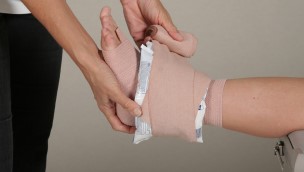Stress fractures of the foot and ankle
A stress fracture is a type of overuse injury. Athletes in sports that involve a lot of running or jumping are prone to this injury. If it is not detected early it may lead to a complete fracture of the bone.

The term stress fracture can be a little confusing, as it is not the same as a «normal» fracture where the bone breaks in two. The term is used to describe a weak point or an area in the bone structure that occurs when the bone tissue deteriorates faster than it can repair itself.
To give an idea of how such an injury develops, think of a pencil or wooden stick that is bent to such an extent that it may soon give way, but it is not yet broken. It is basically the same with a stress fracture. The bone is not yet broken but is at risk of that happening. There are many places in the foot and ankle where a stress fracture can occur.
Risk factors
The most common cause of a stress fracture is a change in training habits. For example, by:
- drastically increasing the amount of training over a short period of time
- starting to train again following an injury or illness
- switching training surfaces (e.g. from grass to asphalt)
There are several factors that, in combination with load, increase the risk of a stress fracture. Women are more prone to stress fractures than men since they have less bone mass and their bone density decreases faster with age. Low muscle strength and muscular endurance may result in higher impacts in the joints and more load being placed on the skeleton. Low levels of calcium and vitamin D affect bone mass density and can thus increase the risk of a stress fracture.
Diet
Having a proper diet can improve your nutritional status and maybe prevent a stress fracture.
Signs and symptoms
There is often localised stinging pain, sensitivity to pressure, and sometimes swelling. The pain develops over time and gets worse with weight-bearing. In the early stages the pain is only felt during training, but after a while it can also occur during day-to-day activities.
Diagnosis
A doctor or physiotherapist will make the diagnosis. In the early stages, it is not common to see signs of a stress fracture using regular X-ray images. As such, MRI is more suitable to confirm the diagnosis.
Treatment
Stress fractures are treated by not allowing weight-bearing of the injured area for around 6 – 8 weeks. This may be done by using a cast or splint. After this period, all activities should be pain-free before allowing return to sport. Seeking advice from a doctor or physiotherapist is advised. Surgery may be necessary in some cases.
During the non-weight-bearing period it is important to identify possible contributing factors, such as running technique, footwear, training program, and nutrition, as well as to make a plan for how to gradually increase training again. For some athletes, it may be useful to have a blood test to measure nutritional levels. Taking dietary supplements has proven to be an effective measure in optimising bone health. A smoother running style with shorter footsteps, a slower pace, and shorter sessions can help decrease symptoms
Prognosis
The prognosis is good. If the diagnosis is made early and the appropriate weight-bearing limits are applied, most stress fractures in the foot and ankle will heal and the athlete will be able to return to their former level of activity.


